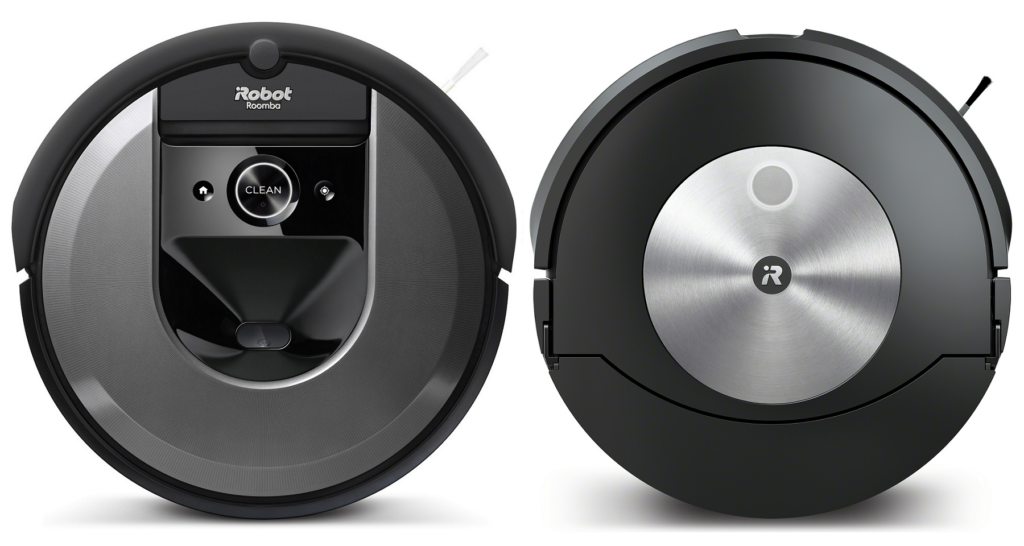In a nutshell, what are the differences between the Roomba i8 and the Roomba j7?
- The Roomba j7 has obstacle recognition and avoidance capabilities, while the Roomba i8 does not.
- Applies to the “plus” models only: the j7+ comes with a docking station that saves a lot of space compared to that of the i8+.
Contents
- 1 In a nutshell, what are the differences between the Roomba i8 and the Roomba j7?
- 2 Similarities between the Roomba i8 and the Roomba j7
- 2.1 Similarity 1: Both models can autonomously start cleaning sessions when you leave the house.
- 2.2 Similarity 2: Both models can create maps of your home.
- 2.3 Similarity 3: Both models are compatible with the Automatic Dirt Disposal.
- 2.4 Similarity 4: Both models can automatically recharge their batteries.
- 2.5 Similarity 5: Both models have a voice commands feature.
- 3 FAQs
- 4 So, Which One Should You Choose?
Difference 1: The Roomba j7 can recognize and avoid pet waste, while the i8 cannot.
With its front-facing camera, the j7 is able to detect objects on the ground: things like shoes, shoelaces, cables, and toys. Most importantly, it will recognize pet waste. When an object is detected, the robot vacuum will modify its route to avoiding running over it.
The i8 does not have the same capability. It will bump into or run over these objects since there is no front facing camera for obstacle avoidance.
If you have pets at home, it’s best to go with the j7. This way, you’ll have the peace of mind of knowing that you won’t have to worry about your pets making a mess inside the house.
iRobot releases periodic updates on the object library, so the j7 and other Roomba models with object recognition should be able to detect even more objects in the future.
However, if you don’t have pets and you keep your floors clutter-free, then the i8 is also a good choice.
Difference 2: The auto-emptying versions of these Roombas come with different docking stations.
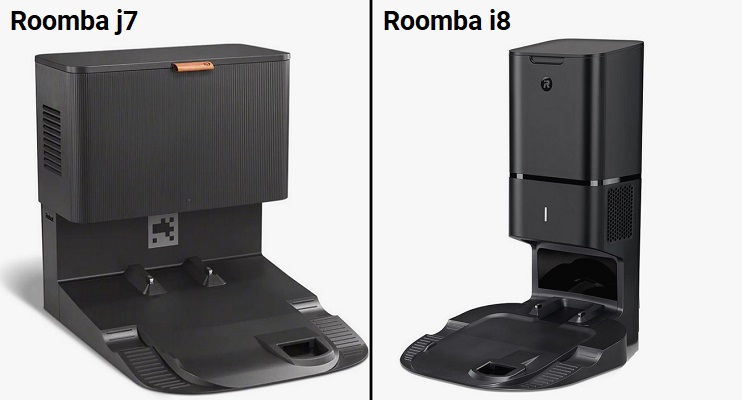
Most Roombas have a regular and a “plus” version, the Roomba i8 and i7 included. The “plus” means these vacuums come with an auto-emptying docking station.
The Roomba i8+ has the 1st generation docking station, which is taller and takes up significantly more space.
The Roomba j7+ has the 2nd generation docking station, which is slightly wider but much shorter.
The space saving design of the j7+ allows you to store it under places where the i8+ won’t allow.
Similarities between the Roomba i8 and the Roomba j7
Similarity 1: Both models can autonomously start cleaning sessions when you leave the house.
If you turn your phone’s location services on, the iRobot app will be able to detect if you’ve left your house. Once you leave, the app will prompt the Roomba to start cleaning your home.
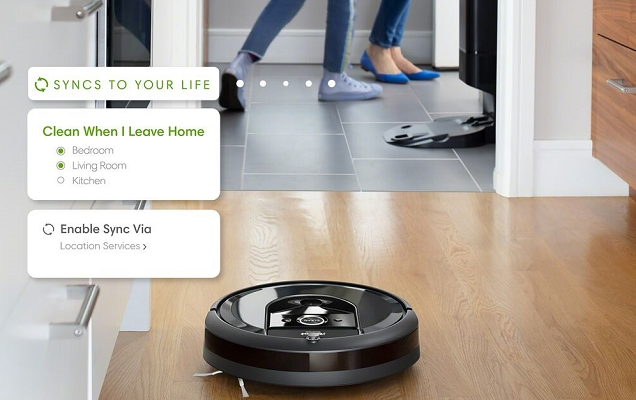
With this feature, you won’t have to create custom schedules because both robot vacuums can autonomously start cleaning your home once you’re away.
This feature can be especially helpful if you don’t keep a regular daily schedule and can’t always predict when you’ll be leaving your home. If you allow the app to keep track of your location, your robot vacuum will clean your home while you’re away. You can thus come home to vacuumed floors without having to do anything.
Similarity 2: Both models can create maps of your home.
Once you bring your robot vacuum home and set it up, it will begin with a few mapping runs so it can start learning the layout of your home. You can bring it to different floor levels so it can map and clean each one.
You’ll be able to save these maps and access them on the app. You can use these maps to set up clean zones in areas of your home that you want the robot vacuum to focus on. Additionally, you can also set up keep out zones over the areas that you want the robot vacuum to avoid.
With the help of the saved maps, you’ll also be able to create customized cleaning sessions and schedules. You can also direct your robot vacuum to clean specific rooms without having to start a whole new cleaning session.
Similarity 3: Both models are compatible with the Automatic Dirt Disposal.
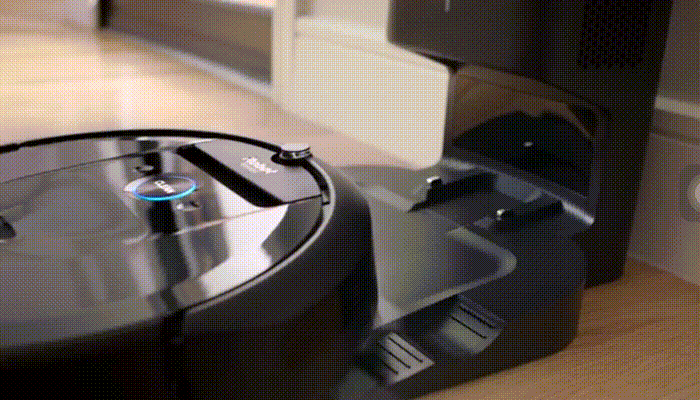
Once your robot vacuum’s onboard dustbin is full, you’ll have to take it out and empty it so it can continue cleaning your home. You’ll have to do this once a day to once every three days, depending on the kind of cleaning sessions you’re running.
With the auto-empty feature, you won’t have to empty your robot vacuum’s dustbin yourself. However, to use this feature, you’d need the Clean Base, which comes bundled with the “plus” versions of these Roombas.
The Clean Base has an onboard waste bag that stores the dirt and debris from the robot’s dustbin. You’ll have to empty this waste bag yourself, but you’ll only have to do so around every 2 months.
Similarity 4: Both models can automatically recharge their batteries.
The i8 and the j7 can clean your home for up to 90 minutes on a single full charge. If you have a large home and the Roomba is unable to finish cleaning on one charge, it will automatically pause the cleaning session and return to its base so it can recharge.
After recharging, the robot vacuum will return to the same spot where it paused its cleaning session and continue cleaning from there. It will then keep pausing, recharging, and resuming its cleaning session as many times as necessary until the entire floor is cleaned.
Similarity 5: Both models have a voice commands feature.

The iRobot app allows you to have as much control as possible over your robot vacuum. You can use it to start and stop cleaning sessions, create cleaning schedules, toggle features and functions, access saved maps, and more.
The i8 and the j7 are also compatible with Google Assistant, Amazon Alexa, and Siri, each of which can enable the voice commands feature.
You can also use the voice commands feature if you want to be able to give your robot vacuum certain directions without having to touch the app. If you’re doing the dishes, cooking, folding laundry, and more, you can simply tell your robot vacuum if you want it to start a cleaning session.
Make sure that your robot vacuum is connected to your wifi to make sure that you can use the app and voice commands feature.
If you don’t have wifi, you’ll still be able to turn the robot vacuum on and start and stop cleaning sessions by using the buttons on the robot. However, you won’t be able to do much else without access to the app.
FAQs
Does the Roomba i8 tell you when the bag is full?
Yes. The iRobot app will send you an alert when it detects that the i8’s dustbin is full and needs to be emptied.
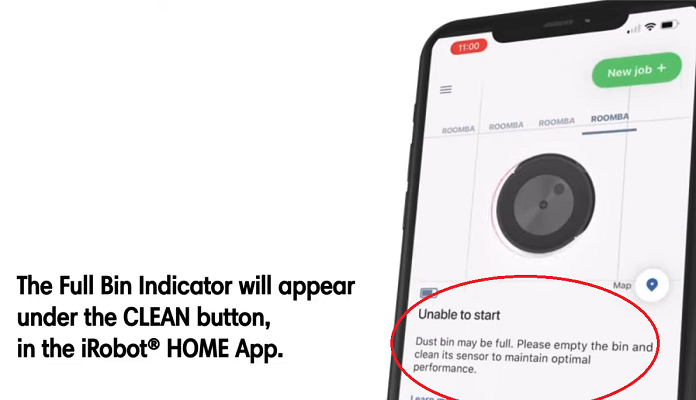
Does the Roomba i8 require wifi?
You can still run the i8 without wifi, and you can use the buttons on the robot vacuum to turn it on and start and stop cleaning sessions. However, wifi is necessary if you want to use the app and voice commands feature.
How often do you need to empty the Roomba j7?
Without the Clean Base, you’ll need to empty the j7 once every day up to once every three days. If you have the Clean Base, you’ll only need to empty the base’s waste bag once every 2 months or so.
How long does the Roomba j7 take to map?
It usually takes the Roomba j7 two to three runs to map your home. However, if you have a particularly large or complicated layout, it could take longer.
So, Which One Should You Choose?
If you have pets at home, the Roomba j7 is simply the better choice. It has object recognition and avoidance capabilities, ensuring that it never makes an accidental mess of your floors. Other than pet waste, the j7 can also avoid things like shoes, toys, cables, and more.
In contrast, i8 also doesn’t have object recognition and avoidance. However, if you don’t have pets at home, you won’t have much need for the object avoidance feature and the i8 will be able to reliably clean your home.
In short, go with the j7 if you have pets. If you don’t have pets, then either the j7 or the i8 would do a fine job.
If you are looking at the auto-emptying versions of these Roombas, the j7+ fits under more places than the i8+ thanks to its shorter design.
